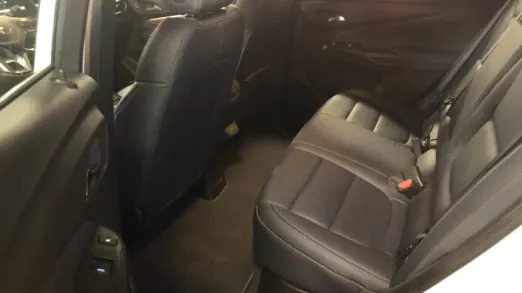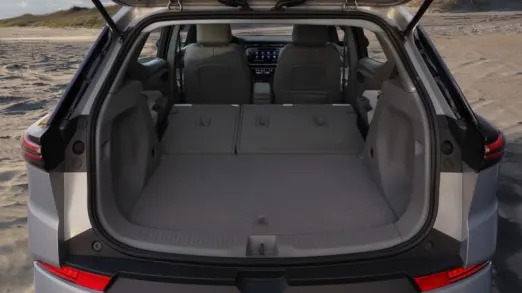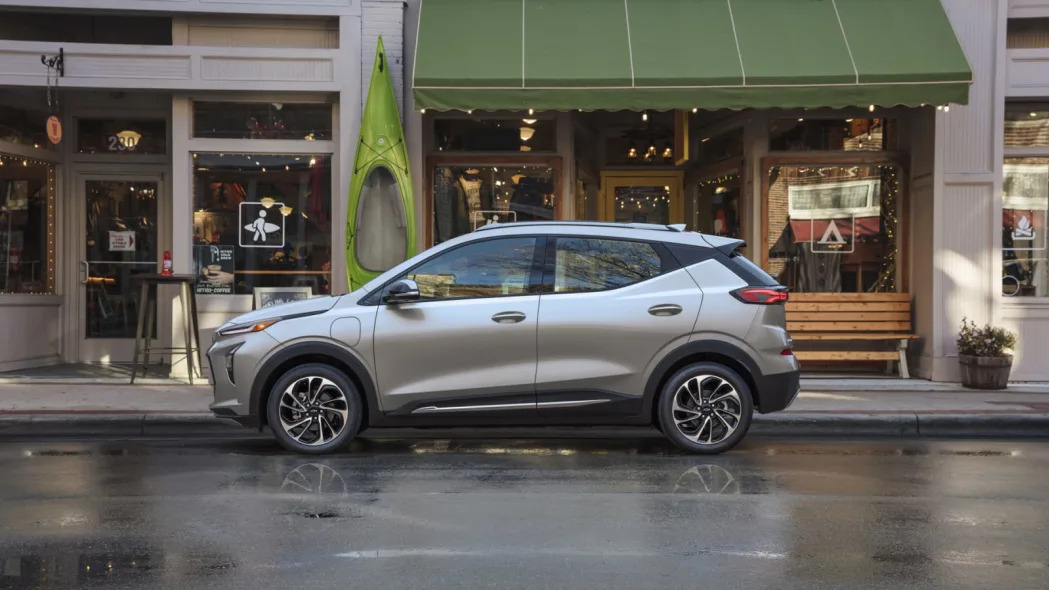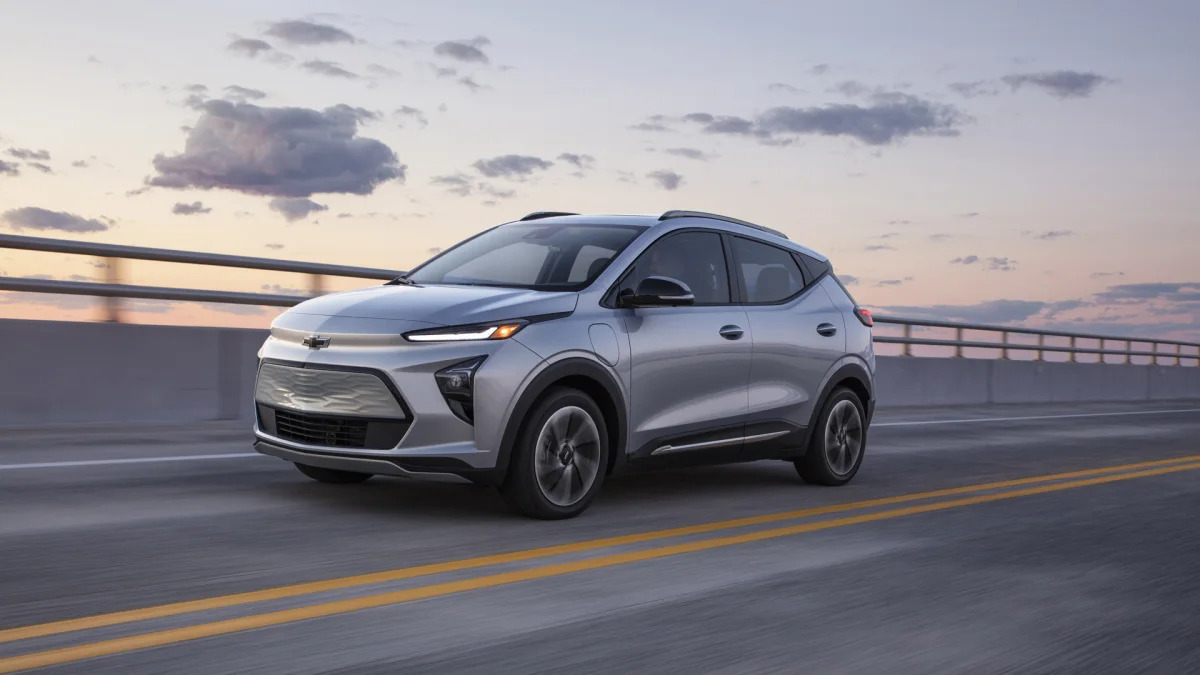-
EnginePermanent magnet electric motor
-
Power200 HP / 266 Lb-Ft
-
DrivetrainFront-Wheel Drive
-
Curb Weight3,679 Lbs.
-
Seating5
-
Cargo16.3 / 56.9 Cubic Feet
-
Base Price$33,995
-
As Tested Price$40,495 (Est.)
TAYLOR, Mich. — For the first time in a long time, the sun was shining and the snow was beginning to melt as we first laid eyes on the 2022 Chevrolet Bolt EUV in person. Less than two weeks after the reveal of the just-slightly-larger sibling to the revised Bolt EV, we were invited to take a brief drive that would highlight one of the most important and interesting features: Super Cruise.
The Bolt EUV is the first non-Cadillac vehicle to get GM's advanced driver assistance system that allows the driver to remove their hands from the wheel in certain scenarios. Super Cruise was impressive enough to win Autoblog’s 2019 Technology of the Year Award, but it has been improved since those early days, with about 70,000 more miles of roads where it can operate, plus refinements to the driver attention system. This is not, however, the new generation of Super Cruise that will perform automatic lane changes with a touch of the turn signal — that system will launch on the 2021 Cadillac Escalade.
The version of Super Cruise in the Bolt EUV combines adaptive cruise control with lane following/centering technology to steer the car (itself a common enough feature these days), then adds a crucial layer of safety with its driver monitoring system, a camera on the steering column that tracks the driver’s face and eyes to ensure that their attention remains focused on the road. When on divided, restricted access highways that have been previously mapped using lidar technology, and when lane markings are clearly visible, the driver initiates Super Cruise by pressing a button on the steering wheel, allowing the car to take over braking, acceleration and steering.
A light bar on the top portion of the steering wheel will turn green when Super Cruise is active, inviting the driver to remove their hands and feet from the controls. So long as the conditions continue to be met (known and allowed roads, clear lane markings, attentive driver), the vehicle zips along at the set speed, slowing down when encountering slower traffic, and steering the car through the curves. The light bar will turn blue when the driver takes control of steering without disengaging — such as during a lane change — and returns to green when the system takes back steering control. The light turns red and the system beeps at you when you need to take immediate control. It’s much more confidence-inspiring, and even relaxing, than you’d think.
Before we hit the road, we had a few brief moments to scope out the Bolt EUV. Of particular curiosity was the rear seat. The EUV has three more inches of wheelbase than the regular Bolt, which equates to a near-equal increase in rear legroom. What a difference it makes, too. While back seat headroom isn’t in great supply, a 6-footer sitting behind a 6-footer has plenty of room to stretch their legs. In all, the EUV is 6 inches longer than its smaller sibling.



In the cockpit, there are some new controls. Unlike the old Bolt EV’s unusual joystick-style gear lever, both 2021 Bolt models get an array of buttons to select Park, Reverse, Neutral, Drive and, new for 2021, one-pedal drive mode. We like that the Bolt will remember whether the latter was on or off when you turn the car off, and will retain the same setting when you return and start the car again. We also enjoyed the inclusion of a camera feed in the rear-view mirror. It can be switch to a standard reflection with the flip of the lever at the bottom, but we preferred the digital view, unimpeded by the rear seat headrests and the shape and size of the rear window.
Our time with the car was limited, so we connected our phone via Bluetooth, turned on Apple CarPlay, and added our drive route into Google Maps for a caravan with other gathered members of the press and Chevy engineers. Our route would be mostly highway driving, but we had a few miles through the industrial surface streets of Taylor before we’d hit our on-ramp.
After driving it like a normal car few minutes, we engaged one-pedal driving, the straightforward yet involving action of modulating the accelerator to speed up and slow down. It's our preferred way of driving most EVs most of the time. Lifting off completely provided plenty of regenerative braking feel to slow us down in time for a red light, but it does so without the instant jarring feeling of falling forward in our seat. Chevy really found a nice balance in the feel of this one pedal driving, which probably shouldn't be surprising, since the brand has been offering it since the first Volt plug-in hybrid a decade ago.
If you’ve driven the original version of the Chevy Bolt, the Bolt EUV will feel familiar. It shares the standard Bolt’s electric powertrain, with the same 65-kilowatt-hour battery providing 250 miles of range (nine less than the standard 2021 Bolt EV), and a single motor sending 200 horsepower and 266 pound-feet of torque to the front wheels. It’s a lot of twist for a little hatchback (or, as Chevy would have you believe, a crossover, which this EUV more closely resembles than the Bolt EV), and the wheels are happy to break traction and let out a joyful squeal when jetting away from a stop sign. It feels positively peppy around town, and that solid acceleration carries over to the highway on-ramp.
Once merged with expressway traffic, I engaged Super Cruise. The light on the steering wheel turned green, and I took my hands off the wheel and feet off the pedals. Not long after, the green light bar began to flash for several seconds before turning red, relinquishing steering controls back to human hands. Everything looked good. Lane markings were clear and we weren’t at an interchange, so I poked the button again. Solid green light, cruising, then flashing again before we were placed back in charge. I tried it a third time, with the same sequence of events.

Turns out this is another problem created by Covid-19: I was still donning my mask from check-in. I took it off, engaged Super Cruise yet again, and enjoyed many miles of smooth sailing. A little experimentation showed that the driver-facing camera could tolerate the mask if sunglasses were removed, or that sunglasses and a bushy beard were totally acceptable.
There was a more common and less 2021-specific disengagement we experienced at highway interchanges. Changing lanes onto an off-ramp would disengage Super Cruise until we had merged onto the next highway. Even more interesting, though, is that it would disengage at an interchange where lanes peeled off from the main road, even if we were continuing straight. For instance, traveling on I-75 North in the left three lanes, Super Cruise disengaged where the right two lanes diverged to become 275. Once past the interchange area, Super Cruise could be reengaged.
With the car’s driver assistance system taking over the most stressful parts of the drive, you’re free to relax, which easier to do in the EUV than in the last-gen Bolt. For one thing, the front seats are much more comfortable than the compromisingly thin things in the original Bolt (that was a space-saving measure to maximize rear legroom, in which this Bolt EUV is in ample supply). There’s some road noise and wind noise, but no more than you’d get from a similar class of internal combustion vehicle — without, of course, the drone of the engine.
We look forward to spending more time with the Bolt EUV, in order to see how we like living with the car for more than a couple hours, and in more driving scenarios. So far, the Bolt EUV impresses. It takes most of what we already love about the Bolt, and improves upon it with a bit more interior space and comfort. We’re also curious to see how it compares to the new Bolt EV — which we have yet to sample — for a more direct comparison. It would be hard to think we’d pick the redesigned Bolt EV over the new EUV, despite the EUV’s base price being $2,000 higher. The extra comfort and available tech make the EUV more appealing. Specifically, Super Cruise is not available in the standard Bolt EV.

The Bolt EUV starts at $33,995 including destination, but one has to opt for the Premier trim ($38,495) or the Launch Edition ($43,495) in order to get Super Cruise. The base Bolt EUV LT comes with wireless Apple CarPlay and Android Auto, a wireless phone charger, and a dual-level charge cord as standard. Chevy will even pay to upgrade your electrical system and install a 240-volt outlet at your home to take advantage of Level 2 charging. Premier adds leather seating, the rear camera mirror, surround view parking camera and adaptive cruise control. Super Cruise is a $2,000 option on the Premier, and it’s included in the price of the Launch Edition. Sadly, GM electric vehicles no longer qualify for the $7,500 federal tax credit.
Frankly, the thought of including both the Bolt EV and Bolt EUV in the lineup seems mystifying. Why offer two Bolts considering the enlarged and more comfortable EUV addresses key customer complaints with a minimal degradation in range? Chevy Marketing Manager Tony Johnson admits that Chevy doesn’t know what the sales mix of the Bolt and Bolt EUV will be, but he thinks they both have their unique strengths in addition to their differences in size and price. The EUV, for instance, offers more in the way of technology (Super Cruise), while the less expensive Bolt EV is a more basic “get this done” vehicle with an extra 9 miles of range. “We’ll see how it shakes out,” he says.
Basically, we’ll have to wait for the market to respond and provide clarity on the merits of the two-Bolt approach. We can declare now, though, is that there is very clearly an improved offering compared to the single Bolt of yesteryear, and it’s got bigger back seat and Super Cruise.
Related Video:










Sign in to post
Please sign in to leave a comment.
Continue